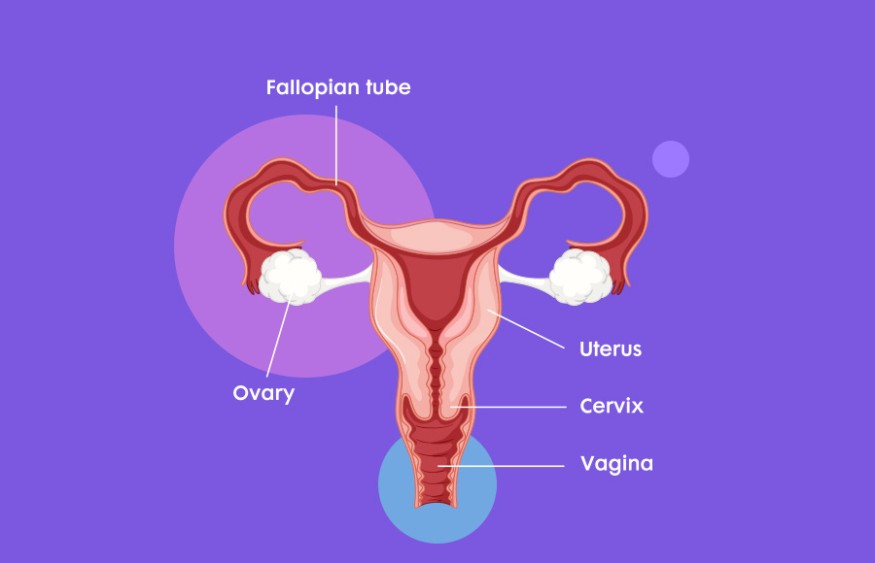
The cervix is a muscular channel that regulates the flow of fluids inside and outside the uterus. It is an important part of the female reproductive system and it changes during pregnancy. The cervix is a small, tightly closed hole that dilates through the three different stages of labor. Before and during pregnancy, it protects the uterus and prevents anything from entering it.
During labor, the cervix begins to open and this process is known as dilation. With this, it opens up completely making way for the baby to come out. The cervix is forced to expand during labor due to the pressure that the uterus exerted by the contractions of the uterus. After delivery, it shrinks back to the previous size and remains soft and floppy. This process might take many days to many weeks to happen.
The cervix protects the uterus and plays a key role in several other vital processes like fertility, the formation of cervical mucus, and childbirth. As mentioned above, it takes several days to come back to the normal size postpartum. During this period, intense care is required. This article will discuss almost everything related to the cervix including its anatomy, healing and recovery, cervical hygiene, vaginal health, and much more. So, dive right in!
Anatomy of the Cervix

Structure
The cervix is a muscular opening that is around 2 to 3 centimeters and is located inside the pelvic cavity. This cylindrical-shaped body part begins at the base of the uterus and extends to the top side of the vagina. In this part of the vagina, the cervix bulges and is called the ectocervix. The cervix consists of other parts as well including the internal orifice (opening to the uterus), the endocervical canal (tunnel extending from the internal os to the ectocervix), and the external os (opening to the vagina). It is held in position by flexible ligaments and it attaches the uterus to the vagina. The cervix narrows at both ends and widens in the middle. The uterus, cervix, and vagina are located behind the bladder and in front of the rectum.
Function
The cervix consists of a cervical canal or passage through which various fluids flow inside and outside the uterus. This passage also has other important functions that are listed below:
Protecting the uterus- The cervix acts as a shield by preventing anything from entering the uterus including objects like tampons or diaphragms that are inserted into the vagina.
Menstruation- The menstrual blood passes through the uterus and cervix and then goes out of the body through the vagina.
Pregnancy- : navigate through the cervix
Fertility- The cervix consists of cervical mucus that plays an important role in pregnancy. Around the time when you ovulate, the cervix secrete mucus that is rich in large proteins called mucins. This mucus is less acidic and thin in nature making it easy for the sperm to pass through the uterus. With this ease of movement, the sperm can easily reach the egg and fertilize it.
Childbirth- The cervix regulates the baby's exit through the uterus during delivery. During pregnancy, the cervix secrets a mucus plug called an operculum that forms a protective barrier around the uterus to prevent the leakage of uterine fluids and the entry of pathogens. The mucus plug dissolves during the first stage of childbirth or just before and the cervix becomes thinner and softer. Then, the cervix dilates or widens for the baby to come out. Looking at the degree to which the cervix has dilated, the time for childbirth can be estimated.
Contraception- The cervix is involved in various methods or techniques of contraception. Cervical diaphragms protect the cervix during intercourse, cervical caps also cover the cervix and progestogen-only pills function as contraceptives by thickening the cervical mucus thereby making it difficult for the sperm to travel through the cervical canal.
Transformation during late pregnancy and childbirth
During pregnancy, the cervix undergoes drastic changes so as to adjust itself to prepare for the baby's exit. This change in the cervix is primarily due to the force caused by the uterus' contractions. The transformation period involves the change in the cervix's firmness to thin, soft, and elastic. Slowly, it begins to dilate or widen. During the first phase of pregnancy, the cervix dilates to around 3 to 5 cm, and in the second phase, it dilates to 10 cm. The second stage is where full dilation happens accompanied by active pushing and contractions. During childbirth, the cervix opens up fully releasing the mucus plug from the cervical canal.
Healing and Recovery
The healing and recovery process of the cervix might be a concern for many. Let us look at this aspect in detail here.
Timeline for cervical changes postpartum
After childbirth, the cervix becomes soft and floppy. In the first few postpartum days, it stays around 2-3 cm dilated. Within one week, dilation decreases to less than 1 cm. Research indicates the cervix takes 3-4 months to revert to its pre-pregnancy size and texture following delivery. The gradual timeline of cervical changes after pregnancy is detailed at SoulFactors.
Signs of normal healing vs. potential complications
During the early period of postpartum, the cervix and the vagina are swollen due to the excessive accumulation of fluid and also bruised. In situations of normal vaginal birth, the cervix begins to narrow down and thicken within a few weeks. Well, it might not become as narrow as it used to be before delivery.
If there is any issue in the cervix such as a tear, there will be serious complications like excessive bleeding. This condition is called postpartum hemorrhage. When such issues occur, it will take more time for the cervix to heal.
When to see a doctor about cervical issues

If there is excessive bleeding due to a tear in the cervix and you feel fatigued, uncomfortable, or unwell, visit a doctor. After pregnancy, if you have constant pelvic pain also, make sure to seek expert advice. Your health professional might carry out some tests to check the health of your cervix.
Postpartum cervical exams and testing
There are several tests and cervical exams that are conducted to check the health of the cervix. The following are the common tests that your gynecologist might ask you to do:
Pelvic Exam
During this examination, the health professional will check the vagina, uterus, and cervix visually and manually to see if there are any abnormalities. Through this test, you can also get to know the status of the cervix tear that occurred during childbirth.
Pelvic Imaging
This is an imaging procedure done to check the cervix closely. The most common procedure is ultrasounds and others include magnetic resonance imaging (MRIs) and computed tomography (CT) scans.
Colposcopy
This test consists of an examination using a special lighted microscope to get a clearer picture of the tissue lining of the cervix. Tissue samples will be collected by your doctor and tested in labs.
Cervical Hygiene

It is important to maintain cervical hygiene as the cervix plays a crucial role in reproduction and supporting other processes like menstruation.
Gentle cleansing techniques
Keep your intimate area always clean. Make sure to clean the area twice a day. Wash with water alone or use mild unperfumed soap.
Avoiding infections
An important part of cervical hygiene is avoiding infections. For this, keep the area clean and dry. If the inner wear gets moist, it might lead to irritation and itchiness.
Menstrual care considerations
During the menstrual period, make sure to keep the area clean. This can be done by changing the pad or tampon in a few hours or cleaning the menstrual cup every day after use.
These hygienic practices have to be strictly followed to maintain cervical and vaginal hygiene.
Supporting Vaginal Health
After childbirth, maintaining vaginal health is a must and this can be done in different ways.
Pelvic floor exercises after childbirth
One thing that you can do after childbirth is pelvic floor exercises. One simple exercise is to squeeze all the muscles at the bottom at the same time and then release them. Repeat this process 8 times. So, just squeeze the pelvic floor muscles, hold them tightly, and then relax them. For effectiveness, try to do 3 sets of 8 to 12 squeezes per day. You can do pelvic floor exercises at any time of the day.
Estrogen cream and other remedies
Estrogen creams can be used to improve vaginal health as it supports healthy discharge. Also, it enhances the health of the vulva and the urethra. Estrogen reduces redness, itchiness, and soreness. Other natural remedies for treating vaginal issues include having more probiotics and taking garlic tablets. These remedies will help treat vaginal dryness, atrophy, soreness, and irritation to a great extent.
Sex and the Cervix
A lot of changes happen in the body after childbirth and this includes vaginal soreness and exhaustion. It takes time for the cervix to get back to its normal size. In case of a tear in the cervix, more time might be required for healing and recovery. As such, there is no specific time to resume sexual activity after childbirth. But, you have to wait for complete physical recovery and adjust to the new changes in sleep and regular routine.
The first thing to do is communicate your feelings with your partner. Keep up the conversation and tell what you feel is good and what doesn't. Though sex after delivery is totally different, it is not bad. You can ease discomfort by experimenting with different positions that might be completely different from what you have been doing before. Some intimate techniques you can use are massage, oral sex, and mutual masturbation. Other methods you can follow to ease pain and dryness include foreplay, using lubricants practicing Kegel exercises. Kegel exercises help strengthen pelvic floor muscles. With these, you can have a fulfilling sex life after childbirth.
Monitoring Cervical Changes
During and after pregnancy, several changes occur in the body. Among these, cervical changes might be one thing you wish to monitor. You can locate and record the position of your cervix in simple steps. First, wash your hands well, find a comfortable position to reach your cervix, slide your finger inside your vagina and locate the cervix, and then record its position. Try to look for changes in tissue softness, the cervical opening, cervical position, and cervical mucus. Other things that you have to monitor include discharge patterns. You can also check the cervical changes using a mirror.
Caring for Your Cervix Long-Term
Ongoing screening and exams will help maintain the health of your cervix for the long term. These will help identify the health of your cervix and if there are any problems. Follow the tips mentioned above, have safe sex, quit smoking, get tested for sexually transmitted diseases, and know the basics of vaccines for sexually transmitted infections. This will help improve cervical health for the next pregnancy as well.
Final Thoughts on the Cervix Through Pregnancy and Beyond
So, from what we have discussed so far, it is evident that the cervix before pregnancy and after are different. The size, shape, and nature of the cervix change during different phases of labor. After childbirth, cervical care is of utmost importance. You can maintain cervical hygiene by keeping the intimate area dry and free from infections. Closely monitor cervical changes manually and also use mirrors. If you suspect any changes or abnormalities in the cervix, consult a doctor and do the tests recommended.
Common tests include pelvic exams and imaging. Review the healing time of the cervix after pregnancy. Any tear or damage caused to the cervix will take time to heal and usually, the time is about 3 to 4 months. So, take extreme care of your cervix and give it time to heal and recover.
© 2026 ScienceTimes.com All rights reserved. Do not reproduce without permission. The window to the world of Science Times.












